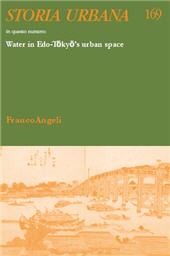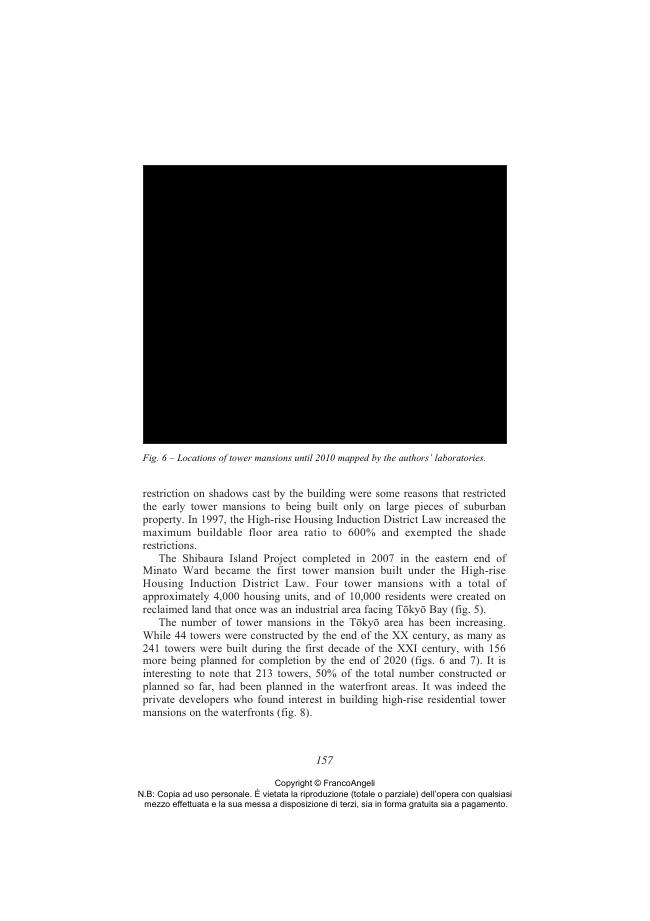Danchi and Tower Mansions : the Origin and Current Situation of Collective Housing in Tōkyō : from Centre to Periphery, from Inland to Waterfront
147-167 p.
This paper is an overview on the location and concentration of housing types in the Tokyo district, with particular focus on danchi and "mansions" (particularly "tower mansions"). The focus is placed on these two types of housing, the danchi developed by the Japan Housing Corporation, a public housing corporation, and the Tower Mansions developed by the private developers. Neither suburban detached houses, nor the governmentsubsidized housing other than that of the Kodan, were included in the analysis in order to keep our argument intact. Danchi (public housing estates) built from 1955 to 1970 were mostly built by replacing forests or agricultural areas in the suburbs. Land developments by Kodan as well as by private developers at that time had been concentrated in the inlands.
The situation changed after the year 2000, when tower mansions, a building type that featured highrise and highdensity apartment buildings, allowed construction on much smaller plots of land than those in the suburbs, promoting brownfield developments near the city. Consequently, danchi, much of which are rental, and publicly owned, were built in inland, while the tower mansions, essentially privately owned, were located near the city, and near the waterfront. These two contrasting housing examples must be highlighted when studying the state of contemporary housing in Tōkyō. [Publisher's text].
Questo articolo presenta una panoramica della collocazione e della concentra zione dei modelli abitativi nel distretto di Tōkyō, con particolare attenzione ai danÂÂ chi e ai "mansions" (in particolare le "tower mansions"). L'attenzione si focalizza su questi due tipi di alloggi, il danchi sviluppato dalla Japan Housing Corporation, una società di edilizia residenziale pubblica, e le tower mansions costruite da privaÂÂ ti. Né le case unifamiliari suburbane né le abitazioni sovvenzionate dal governo diÂÂ verse da quella del Kodan sono state incluse nell'analisi allo scopo di non alterare la nostra linea argomentativa. I danchi (complessi residenziali pubblici) costruiti dal 1955 al 1970 furono edificati principalmente sostituendo foreste o campi agriÂÂ coli nelle periferie. Lo sfruttamento delle terre da parte della Kodan così come quelli dei privati si concentrarono a quel tempo nell'entroterra.
La situazione è cambiata dopo il 2000, quando le "tower mansions", un tipo di edificio di elevata altezza e ad alta densità di appartamenti, ha permesso di edificare su appezzamenti di terreno ben meno estesi rispetto a quelli impiegati nella periferia, favorendo lo sviluppo di aree dismesse vicino alla città. Di conseguenza, i danchi, molti dei quaÂÂ li sono in affitto e di proprietà pubblica, furono costruiti nell'entroterra, mentre le "tower mansions", che sono essenzialmente di proprietà privata, si trovano vicino alla città e a ridosso dell'acqua. Questi due contrastanti esempi abitativi devono esÂÂ sere evidenziati quando si studia lo stato dell'edilizia abitativa contemporanea a Tōkyō. [Testo dell'editore].
Fait partie de
Storia urbana : rivista di studi sulle trasformazioni della città e del territorio in età moderna : 169, 2, 2021-
Articles du même numéro (disponibles individuellement)
-
Informations
Code DOI : 10.3280/SU2021-169007
ISSN: 1972-5523
KEYWORDS
- Danchi Tower mansions Tōkyō Edilizia residenziale Waterfront
- danchi, tower mansions, Tōkyō, collective housing, waterfront



